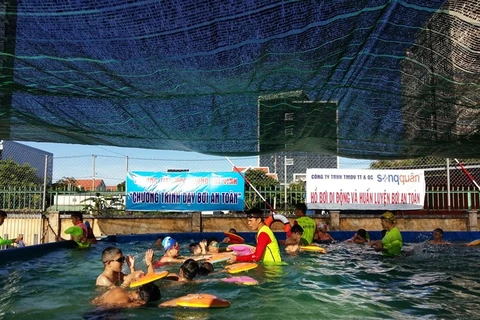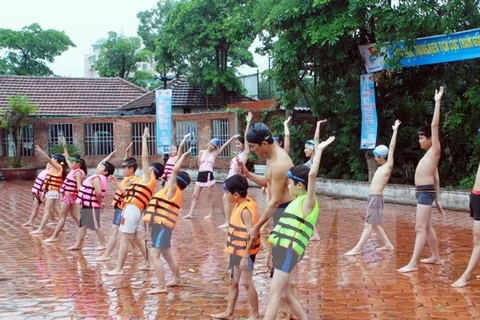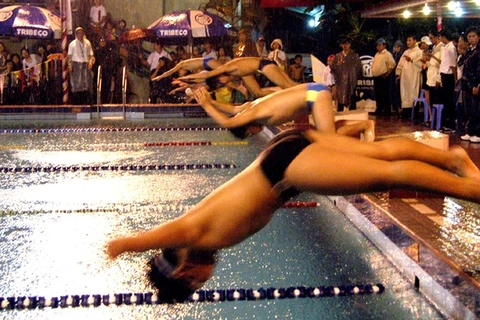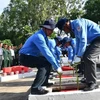 Children learn swimming at Tang Bat Ho swimming pool in Hanoi’s Hai Ba Trung District. (Photo: VNA)
Children learn swimming at Tang Bat Ho swimming pool in Hanoi’s Hai Ba Trung District. (Photo: VNA) Dang Hoa Nam, director of the Child Care and Protection Department, said many children go swimming when it’s hot but do not have swimming skills.
Though Vietnam boasts 3,260km of coastline and many rivers and lakes, swimming is only taught as an extra-curricular activity or at courses outside schools.
A recent survey by the department found only 35 percent of children in the Mekong Delta and 10 percent in the Red River Delta can swim.
The rate of children who can swim in cities is lower than in rural areas, according to the department.
In late 2010, the Government approved a 10-year strategy aimed at having all schools include swimming lessons in their extra-curriculum activities and universalise swimming among all students by 2020.
All provinces were instructed to pilot swimming programmes in primary schools by 2015, with a focus on third, fourth and fifth grade students.
The situation appears to have been somewhat improved. Ministry of Labour, Invalids and Social Affairs data shows that the number of children who died of drowning dropped from 3,300 in 2012 to 1,800 in 2014.
Nonetheless, the goals are still far from fulfilled as most schools can’t teach swimming regularly due to a lack of swimming instructors as well as money and land to build pools.
Vu Duy Anh, an official from the Ministry Education and Training, said teaching students to swim had been difficult due to limited funds and poor infrastructure. “Many schools don’t have swimming pools and it is difficult to build them depending only on State fund,” he told Nong Thon Ngay Nay (Countryside Today) newspaper.
The ministry has encouraged schools to work with organisations and individuals to hold swimming courses in and outside schools.
Duong Thi Sau, head of education and training office in Hanoi’s Dong Anh District, said only 30 percent of students in local schools could swim, although the capital has many lakes and ponds.
Deputy Minister of Labour, Invalids and Social Affairs (MoLISA) Dao Hong Lan advised schools to be more creative, suggesting using pools made of waterproof materials instead of cement, or swimming training in rivers instead of waiting for funds from the State.
Last week, at least 10 drowning cases occurred, with more than 10 children dying in Binh Phuoc, Tien Giang and Quang Ngai provinces. Two of the dead were aged eight, Vietnam Television reported. These children came from poor families and their parents were at work when the incidents occurred, it reported.
On April 25, two secondary school children in the central province of Quang Ngai drowned at a waterfall in Son Ha District. Earlier, four other sixth grade students in Gia Lai Province were reported to have drowned in a local river.
Nguyen Trong An, former deputy director of Child Care and Protection Department of MoLISA, attributed the problem mainly to the carelessness of families and concerned agencies.
“Leaders of provinces and cities will find solutions to overcome current difficulties, such as funds to build pools or organise swimming courses for local children if they are really interested in the children’s rights and safety,” An told Vietnam Television recently.
They could seek investment from organisations, individuals and the community, he added.
The ministry sent a letter requesting the People’s Committees of provinces and cities to strengthen work to prevent children drowning, Nam said.
Provinces would also need to review areas where drowning is common to ensure the safety of children during summer, rainy and flood seasons.
Localities were urged to set up warning signs at dangerous ponds and holes, increase communication activities to raise public awareness and mobilise efforts from different ministries, sectors, and communities to prevent child drowning, An said. – VNA
VNA























